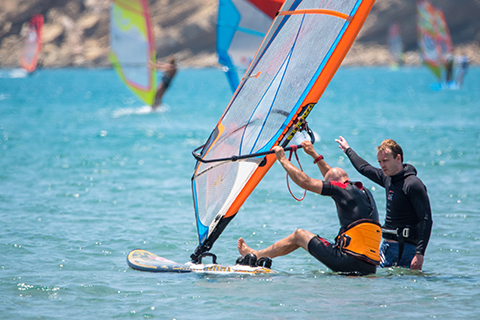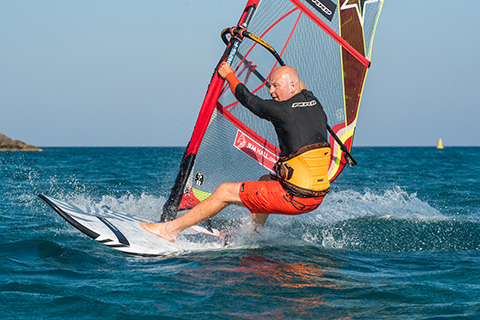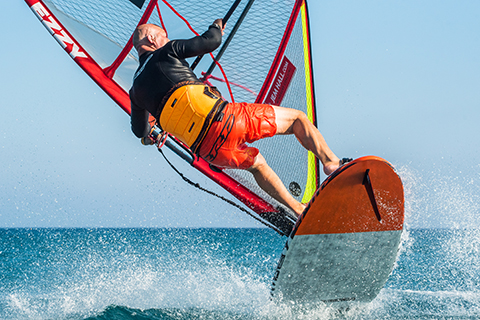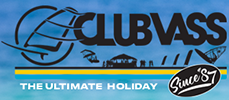JEM HALL
MOVE ON UP – WINDSURFING TECHNIQUE
IMPROVEMENT
My technique pieces mainly reflect on how best to go about nailing a certain move or employing a strategy to ‘move on up’. This month however we help you identify the barriers to your improvement. The most important insight I have is you have to WANT IT! I will go onto identify the main areas that may not be maximising your potential and then look at the key moves and where I see frequent mistakes. I am drawing on my 25 years of coaching and also what I observe on many beaches around the world. Understanding much of this will help you become better at self coaching, which is one of the key ways to improve and enjoy your windsurfing more.
With Jem Hall // Photos Clark Merritt & Nicolas Jones.
www.jemhall.com
(This feature originally appeared in the July 2019 issue of Windsurf Magazine. To read more features like this first, Print and Digital subscriptions are available.
PHYSICAL
It has to start with this, windsurfing is physical and requires a high level of fitness. If you are fitter, and perhaps more importantly stronger and more dynamic you are able to sail with more power and for longer. In effect you become able to dominate your equipment and be a pilot and not a passenger. I am now training more effectively and harder and have noticed huge benefits in my sailing. My stronger and fitter clients improve the fastest, enough said!
MENTAL
The mental aspect also plays a huge part too. As I said you have to ‘want to improve,’ and in sports coaching this can be called your ‘need to achieve’ or ‘achievement motivation’, which boils down to your ‘motive to succeed’ (how much you want it) minus your ‘motive to avoid failure’ (how much you want to avoid crashing). So yes you have to want it, A LOT, and be willing to crash as part of your journey.
An area which can hold people back is our internal self-dialogue, “I can’t do this,.. I am scared, .. I will never achieve this or that.” If you can change this to “I shall or I will or I can”, then you are already on an upward curve.
I have also seen that visualisation can play a big part in how much we all improve. Some people can see how a whole move works, but visualising, understanding and working on key stages / parts of a move is more effective.
“ The most important insight I have is you have to WANT IT!”

Solid gybe but too oversheeted and front knee needs to drive more forward. Photo Nicolas Jones.
KIT
The main kit areas I see that limit our improvement are below.
• Using or owning the wrong kit. It might be too big or too small, too fast or too slow, or just unsuitable for your level.
• Wrong combinations. Sail too big on a small board or vice versa, sails and boards too close together in size.
• No tuning. Not taking the time to change footstrap sizes or positions or adjusting outhaul. Both are 2 easy fixes.
• Changing kit. Going out with one setup that is not working and then sticking with it in the hope that the conditions (or even you or your ability) will change. For example, wind comes up and we don’t increase outhaul and change down board size.
SOCIAL
Who do you sail with and how do they affect you? Perhaps their external dialogue can affect your internal dialogue. We know the person who is often saying it is too windy/gusty/light, avoid these drains on your potential. The collective can be very powerful and I notice this a lot by how the peer group’s positivity and resilience can really help everyone improve on my coaching clinics.
LOCATION
Are you choosing the right place with the forecast on offer and will it help or hinder your progress?
Flat water or waves, you know where these spots are, but it is you that has to want it and who will take the option to drive there. Perhaps this is heading to flat water to nail your tacks, or driving further to waves, rather than carving huge grooves in the ocean on your same old choppy local waters.

Nice one-handed jump here, but I took off into the wind and my tail needs to be up. Photo Nicolas Jones.

Better technique in beach starts leads to learning and improving waterstarts faster! Photo Nicolas Jones.
THE MAIN MOVES
I will now impart the main inhibitors of progress across key moves and aspirational ones too.
Stance
You may have heard me say it before, but a bad stance really can be the root of all evil and a major stumbling block in swift progress. If you have the ‘trinity’ nailed you will develop way faster. As a reminder, the ‘trinity’ is plane early, sail fast, and get/keep upwind. The public enemies are:
• Gear gazing.
• Hands too wide apart.
• Front hand too far forward.
• Stiff hips, i.e. not working with the wind.
• Poor wind observation.
• Front knee bending too much; a symptom of tight footstraps sometimes.
• Back leg too straight; too short harness lines can be a cause of this.
• Too close to the boom and excessive arm bending; again too short harness lines can be a cause of this.
• Oversheeted back arm.
• Front shoulder lifting up.
Starts
Our starts are an extension of our stance, so read the above list to see where our beach and waterstarts can fail. The errors I mainly see are:
• Poor wind awareness.
• Bad stance leading to poor power control.
• Poor steering, worsened through gear gazing.
• Back leg too straight, forcing nose into the wind and lowering available lift from the rig.
• Pulling in on the boom on the way up.
• Oversheeting the sail at the top of the start, which leads to losing the power in the rig or going into a catapult.
• Poor back foot placement.
“A bad stance really can be the root of all evil.”

This carving tack has lots of positives yet I am oversheeted and my bum needs to be forward and out more. Photo Nicolas Jones.

This flat water forward can be improved by my back hand moving back and tucking up my back leg. Photo Nicolas Jones.
Gybes
This is a highly complex move and one which can be improved by following all the guidelines I have mentioned in my more detailed articles over the last year or more. There can be a whole host of errors, but these are the main ones in the planing carve gybe.
• Back hand not far enough back.
• Unhooking badly.
• Not getting enough speed before starting to carve.
• Not going forward with the rig into the turn.
• Knees and mainly ankles need bending and softening.
• Looking at the rig.
• Oversheeting the sail whilst carving, which leads to not opening the sail mid carve.
• Imprecise footwork.
• Rushing the exit.
• Being too close to the rig throughout (bad stance hangover).
• Hooking in too early after coming out of the move.
• Board too small, or too big and fin way too big.
• Not being upwind enough so arc is too tight and not being able to tack will limit gybe growth! Full tack tips coming soon!
Jumps
This is a fun move and has many areas to be improved upon, but I have seen time and again this move not reaching its potential. Here is why.
• Unhooking badly and learning to jump hooked in.
• Not getting over the board pre jump.
• Not sheeting out before popping.
• Upwind line into the jump and in the air.
• ‘Starfishing’ in the air, arms and legs extending.
• Tail down and rail low or down.
• Oversheeting in the air causing nose dives.
• Trying weird donkey kick things before being good at a regular high or long ‘floaty’ fun jump.
• Only jumping off waves so the ocean does a lot of the work.
• Trying to loop before actually being able to jump with control and land and keep some speed.
Loops
If stance can give you a hangover in starts, then your jumping majorly affects your (forward) loops. Here are the main actions that people exhibit when limiting their looping skills:
• Poor preparation, back hand not back and not getting over the board.
• Not committed to the move 100%.
• Not going downwind to take off when learning the move.
• Trying the harder back loop off of waves and over rotating these when the forward is more available to you.
• Oversheeting in the pop and throughout the move.
• Not getting the rig forwards and across.
• Not tucking up the back leg all the way through the move.
• Not extending their front leg and arm enough.
• When going higher people often do not flatten the board at the apex and steer enough.
• Not trying MORE forwards when over or underpowered, and only looping on ‘perfect’ sized kit.
Rides
This is a huge area to cover, so I will present just a few areas that limit your wave riding improvement and enjoyment.
• Poor wave selection and positioning, not being able to tack worsens this and the tack will be covered in my articles over the next year.
• Not getting enough speed on the wave before making turns, mainly by not starting a wave ride dropping down from the top.
• Not coming far enough away from the wave to be able to turn to get back up it.
• Doing too many turns and in effect just wiggling around too much.
• Not working with the wave and seeing how and where to get energy from whilst on the wave.
• Not moving the back hand. Front hand too far forward.
• Once people have got better they often do not mix up their wave riding, i.e. do cutbacks, lip slides, aerials etc.
• Gybe and stance hangovers lead to wave riding mistakes, like not getting the rig away and looking out of your top turn (gear gazing) or moving our back hands enough.
• Standing up in, through and out of the turn.
“ Gybe and stance hangovers lead to wave riding mistakes.”
RRD boards, wetsuits & softwear, Ezzy sails & Black Project fins sponsor Jem Hall. Get him live and direct on one of his highly acclaimed coaching holidays but be quick as they are selling out – check out his website www.jemhall.com for details. You can also follow him on twitter / Facebook / Instagram.
www.jemhall.com



